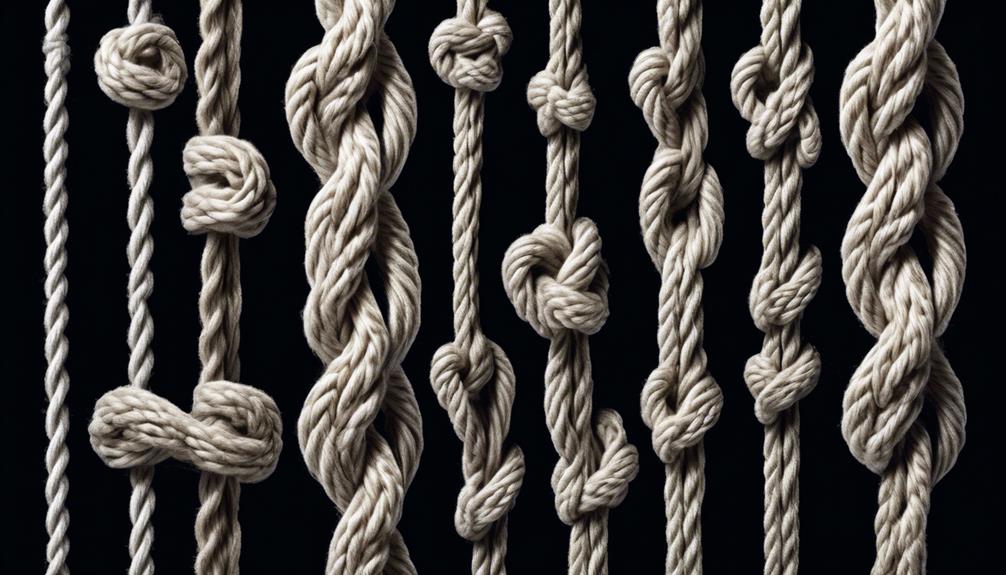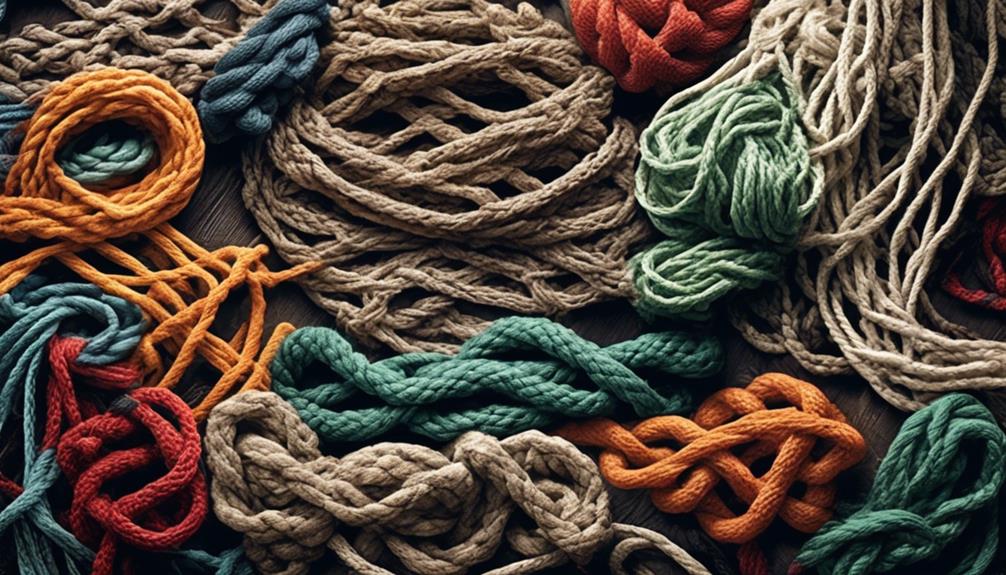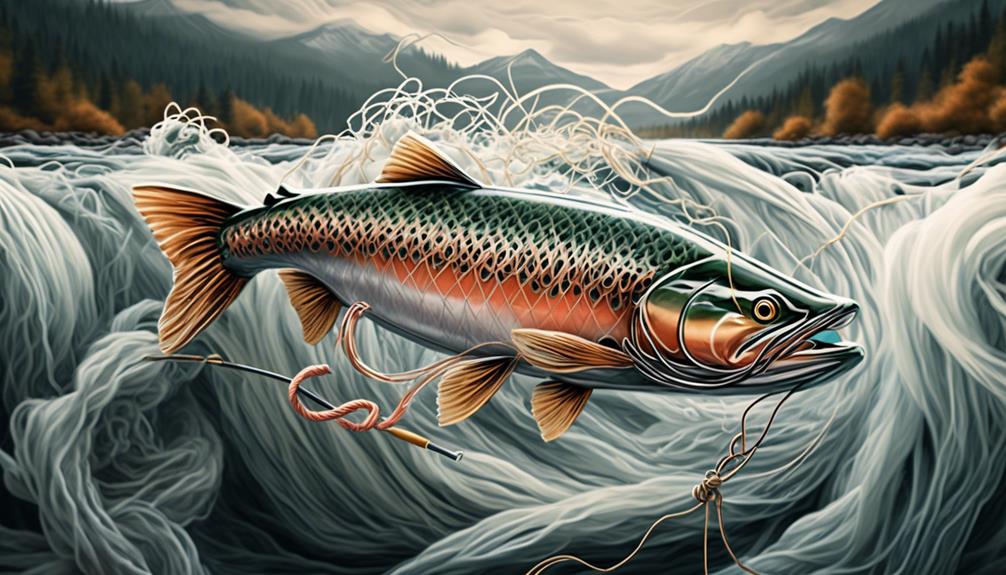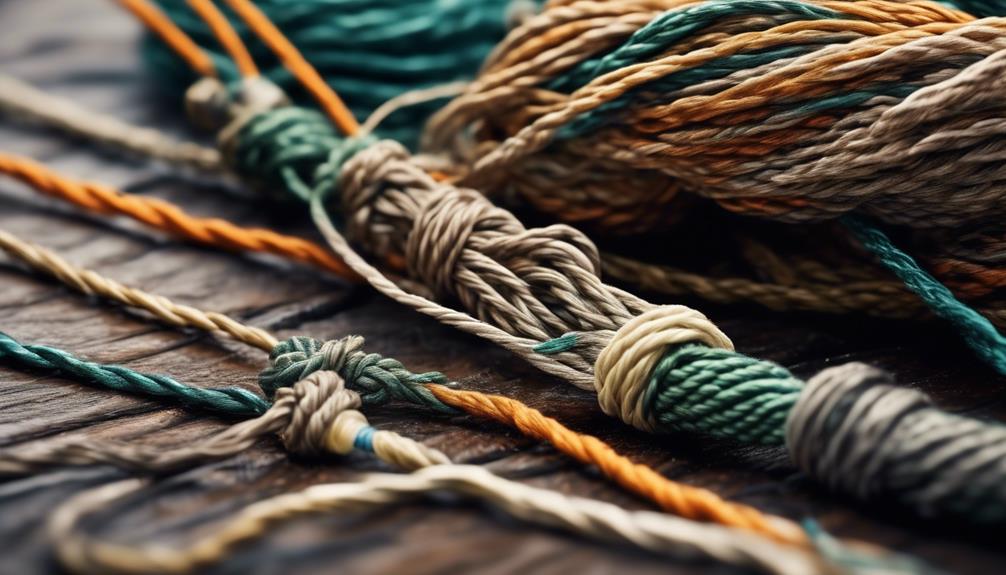When it comes to fishing knots, choosing the right one is like selecting the perfect tool from a well-equipped toolbox. Each knot has its unique strength and purpose, and understanding their differences can make or break your fishing success.
You may have your go-to knot, but what if there's a better option out there that you haven't tried yet? Well, today, we're going to uncover the top 6 fishing knots and compare their strength, so you can be confident that you're using the best one for your next big catch.
Palomar Knot
To tie the Palomar Knot, begin by doubling the line and passing it through the eye of the hook. One of the key advantages of the Palomar knot is its ability to retain nearly the full breaking strength of the fishing line, making it reliable when targeting larger fish species. This knot is highly regarded for its strength and is a popular choice among anglers.
When tying the Palomar knot, it's essential to moisten the knot before tightening it. This helps to prevent friction and ensures a secure knot. Additionally, make sure the doubled line is long enough when forming the overhand knot to avoid complications during the tying process. Double-check that the wraps are formed neatly to avoid potential weak points in the knot. One common mistake when tying the Palomar knot isn't ensuring that the wraps are parallel, which can lead to reduced knot strength. It's important to pay attention to these details to maximize the knot's reliability.
Anglers appreciate the Palomar knot for its simplicity and effectiveness, especially when using monofilament or braided lines. Its strength and ease of tying make it a valuable knot to have in your repertoire, particularly when targeting large or hard-fighting fish species.
Improved Clinch Knot
You can secure your fishing line with confidence using the Improved Clinch Knot, a reliable and straightforward knot for attaching a hook or lure. This knot is popular for its strength and simplicity, making it a favorite among anglers.
Here's why the Improved Clinch Knot is a go-to choice for many fishing enthusiasts:
- Knot Strength: The Improved Clinch Knot is renowned for its exceptional strength. When tied correctly, it can withstand the force of fighting even the most robust fish. This reliability gives anglers peace of mind, knowing that their knot is unlikely to fail when reeling in a prized catch.
- Tying Technique: The tying technique for the Improved Clinch Knot is relatively easy to master. Start by threading the line through the eye of the hook and then doubling back to make five or six turns around the standing line. After threading the tag end back through the formed loop, wet the knot before tightening to ensure a secure hold. The uncomplicated process of tying this knot adds to its appeal, especially for beginners or those fishing in low-light conditions.
- Versatility: This knot isn't only suitable for attaching hooks and lures but can also be used to secure swivels or to tie the line directly to the lure. Its versatility makes it a valuable skill for anglers engaging in various fishing techniques and styles.
Mastering the Improved Clinch Knot is a valuable skill that will serve you well in your angling endeavors, offering both strength and ease of tying.
Uni Knot
When securing your fishing line, the Uni Knot offers a versatile and reliable option for attaching hooks, lures, or swivels. The uni knot strength is one of its most impressive features, making it a popular choice among anglers. Whether you're targeting small panfish or battling large game fish, the uni knot provides the strength needed to secure your terminal tackle.
One of the key advantages of the uni knot is its versatility. This knot can be used in various fishing scenarios, including freshwater and saltwater fishing. It's suitable for monofilament, fluorocarbon, and braided lines, making it a go-to knot for many anglers. The uni knot's versatility also extends to its applications, as it can be used to tie on hooks, attach lures, or connect swivels with ease.
In terms of uni knot strength, it consistently performs well in tensile tests. When tied correctly, the uni knot retains a high percentage of the line's original strength, giving anglers confidence when targeting powerful fish species. Its reliability under pressure makes it a dependable choice for various fishing techniques, such as casting, trolling, or bottom fishing.
San Diego Jam Knot
The Uni Knot's versatility and strength make it a top choice for anglers, and now we shift our focus to the San Diego Jam Knot, a reliable option for securing your fishing line in various scenarios.
The San Diego Jam Knot is highly regarded for its strength and is especially popular among anglers who target larger, hard-fighting fish.
Here's what you need to know about the San Diego Jam Knot:
- San Diego Jam Knot strength: This knot is known for its exceptional strength, making it a go-to choice for situations where you need to exert maximum pressure on the line. Its ability to maintain near full line strength is particularly advantageous when targeting powerful game fish, providing the confidence needed to tackle challenging catches.
- San Diego Jam Knot applications: The knot's reliability and strength make it suitable for a wide range of fishing scenarios. Whether you're casting from shore, fishing in deep waters, or battling fish with strong, sudden runs, the San Diego Jam Knot holds up admirably. Its versatility extends to various line types, including monofilament, fluorocarbon, and braided lines, making it a versatile option for anglers.
- Ease of tying: Despite its impressive strength, the San Diego Jam Knot is relatively easy to tie, even in low light or adverse weather conditions. Its simplicity and effectiveness make it a valuable addition to any angler's repertoire, ensuring that your line remains secure when it matters most.
Double Uni Knot
Exploring the versatility of the Double Uni Knot showcases its effectiveness in connecting lines of different diameters with ease and reliability. When it comes to strength comparison, the Double Uni Knot stands out as one of the most reliable knots for joining lines. It's particularly adept at connecting lines of varying thickness, making it a popular choice among anglers for securing leader lines to the main line. This knot is known for its exceptional strength, ensuring that it can withstand the intense pressure of reeling in large and powerful fish.
One of the notable advantages of the Double Uni Knot is its adaptability to different fishing techniques. Anglers can utilize variations of the Double Uni Knot to suit their specific fishing needs. For instance, the Double Uni Knot can be employed to tie a leader to the main line in both spinning and baitcasting setups. This adaptability makes it a highly versatile knot for a wide range of fishing scenarios.
In terms of technique variations, the Double Uni Knot offers flexibility for anglers who prefer different approaches to knot tying. Whether you're a beginner or an experienced angler, mastering the Double Uni Knot and its variations can significantly enhance your fishing experience. The knot's simplicity and reliability make it a valuable addition to any angler's repertoire.
Blood Knot
To master the Blood Knot and its variations, you can enhance your fishing experience and expand your knot-tying skills, building on the adaptability and reliability of the Double Uni Knot. The Blood Knot is a popular choice for joining two lines of similar diameter, making it a valuable addition to your knot-tying repertoire.
Here's what you need to know about the strength comparison and tying technique of the Blood Knot:
- Strength Comparison: The Blood Knot is renowned for its exceptional strength, making it a preferred choice for anglers targeting larger and stronger fish species. When properly tied, this knot maintains a high percentage of the line's original strength, giving you the confidence to tackle formidable opponents in the water.
- Tying Technique: Mastering the tying technique of the Blood Knot is essential for its effectiveness. This knot involves wrapping the two lines around each other in a precise manner, creating a secure and streamlined connection. With practice, you can perfect the art of tying the Blood Knot, ensuring that it holds up under the pressure of battling powerful fish.
- Versatility: One of the key advantages of the Blood Knot is its versatility. Whether you're using monofilament, fluorocarbon, or braided lines, this knot can be adapted to suit various fishing scenarios, making it a reliable choice for different fishing conditions.
Incorporating the Blood Knot into your knot-tying arsenal can significantly elevate your angling game, providing the strength and dependability needed to reel in your prized catches.
Surgeon's Knot

Mastering the Surgeon's Knot will enhance your knot-tying skills and provide a reliable method for joining two lines of different diameters. When it comes to strength comparison, the Surgeon's Knot is a top performer. It's an excellent choice for connecting monofilament to fluorocarbon or monofilament to braided lines. The tying technique is relatively simple, making it a favorite among anglers.
To tie the Surgeon's Knot, overlap the two lines to be joined. Form a simple loop by doubling one of the lines and then passing the end through the loop. Repeat this process by doubling the other line and passing it through the loop in the opposite direction. Moisten the knot and slowly draw the lines together, ensuring that the coils tighten smoothly. Once the knot is snug, trim the tag ends.
In terms of strength comparison, the Surgeon's Knot holds its own against other popular fishing knots. When properly tied, it retains a significant amount of the lines' original strength. This makes it a reliable choice, especially when working with lines of different diameters. With its simple tying technique and impressive strength, the Surgeon's Knot is a valuable addition to any angler's repertoire.
Albright Knot
The Surgeon's Knot is a reliable choice for joining two lines of different diameters. However, when facing the challenge of connecting lines of similar or varying materials, the Albright Knot is an excellent alternative. The Albright Knot is a standout performer in terms of strength comparison, making it a popular choice among anglers.
Here's why the Albright Knot is a top contender:
- Strength Comparison: The Albright Knot is renowned for its exceptional strength. When properly tied, this knot retains a high percentage of the line's original strength, making it ideal for securing heavy lines or when targeting large, powerful fish species.
- Tying Technique: Despite its impressive strength, the Albright Knot is relatively easy to tie. Its simple and efficient tying technique makes it a favorite among anglers who need a reliable knot that can be quickly and easily executed, especially when out on the water.
- Versatility: The Albright Knot's versatility is another reason for its popularity. It can be used to join lines of different materials, such as monofilament to braided lines, or lines of similar diameters. This flexibility makes it a go-to knot for various fishing scenarios, adding to its appeal among anglers seeking a reliable and adaptable connection between lines.
Frequently Asked Questions
Are There Any Specific Types of Fishing Lines That Work Best With Each of These Knots?
When it comes to fishing line compatibility, it's important to match the type of fishing line with the specific knot you're using.
Certain knots may work better with monofilament lines, while others are more suitable for braided lines.
Additionally, when facing knot-tying challenges in adverse weather conditions, it's essential to choose knots that are easier to tie and maintain their strength even in rough weather.
Can Any of These Knots Be Used for Both Freshwater and Saltwater Fishing?
Yes, some of these knots can be used for both freshwater and saltwater fishing. Knot strength and versatility make knots like the Palomar and the Improved Clinch suitable for various fishing environments. They hold up well in both freshwater and saltwater conditions.
These knots also have minimal environmental impact and are easy to tie, making them practical choices for different fishing settings.
Are There Any Special Techniques or Tips for Tying These Knots in Windy or Rainy Conditions?
When tying knots in windy or rainy conditions, consider using larger and more visible lines.
For windy conditions, find a sheltered spot and use your body to shield the knot from the wind.
In rainy conditions, keep your fishing lines dry and use a waterproof knot-tying tool if needed.
Ensure the knot is tight and secure, as wet conditions can weaken knots.
Adapt your techniques based on the specific fishing scenarios and targeted fish.
Can These Knots Be Used for Tying Together Different Types of Fishing Lines, Such as Braided Line to Monofilament?
Yes, these knots can be used for tying together different types of fishing lines, such as braided line to monofilament. It's essential to consider knot strength and line compatibility when doing this.
In challenging weather conditions like wind or rain, utilizing specific fishing techniques can help ensure a secure knot.
When tying different types of lines, it's crucial to choose the right knot and technique to maintain strength and prevent slippage.
Are There Any Specific Types of Fish or Fishing Situations Where One of These Knots Excels Over the Others?
When it comes to specific fish types, certain knots excel over others. For deep sea fishing, you'll want a knot that can handle heavy loads, like the Palomar or San Diego jam.
However, for fly fishing techniques, knots like the improved clinch or the surgeon's knot may offer better performance. Understanding the strength comparison between these knots will help you choose the right one for your specific fishing situation.
Conclusion
So there you have it, the top 6 fishing knots compared and contrasted.
Each knot has its own strengths and weaknesses, so it's important to choose the right one for the job.
Whether you're tying on a lure or connecting two lines, knowing these knots can make your fishing experience more successful.
Keep practicing and perfecting these knots, and you'll be ready for any fishing situation that comes your way.
Happy fishing!



